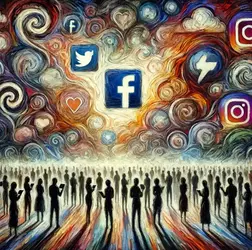By Rajan Tiwari
September 10, 2024

In the vast expanse of cyberspace, speech flows with minimal restrictions, offering a seemingly ideal playground for the expression of ideas. However, this freedom often leads to the accrual of hate speech, particularly targeting a section of the society. This write up delves into the realm of hate speech directed at Indian communities.
"Pajeet” is actually a far-right slur for Hindus and Sikhs. From its humble beginnings in 2015, the term “Pajeet” has experienced exponential growth, culminating in its peak prevalence in the year 2024.
In the twisted iteration of “Pajeet, My Son,” the comic strip takes a derogatory turn, mocking Indians and India itself, particularly regarding issues of open defecation.
The truth side of the story is that the Government of India started Swachh Bharat Mission programme on the theme of ODF (Open Defecation Free) 10 years before after Narendra Modi came to power. India has made notable progress in sanitation, meeting Sustainable Development Goals through initiatives like Swachh Bharat Mission.
Achieving 100% sanitation coverage by 2019 is commendable. The Government of India aims to make India ODF Plus by 2024-25. Hence, it is highly objectionable to tarnish the image of the conuntry in the name of an issue that no longer exists.
The Twitter (presently X) platform serves as a hotbed for hate speech in various forms: text, memes, and videos. What’s particularly disturbing is the accompanying use of Hindu symbols such as the swastika or forehead markings. Hinduphobic terms like “cow piss drinker,” “dung worshipper,” and “kaffir” are liberally deployed, perpetuating stereotypes that depict Indians as backward, dirty, and unintelligent. Furthermore, violent language and imagery intensify the toxicity, while Hindu-specific symbols like tilaks and bindis amplify the hate.
A yearly analysis provides a comprehensive overview of tweet proportions. Notably, in 2024 (Jan-Feb), tweets surged to over 60%, a stark increase compared to 2023 and 2022. Specifically, there were 563 tweets on #Pajeet in 2024, 334 tweets in 2023, and merely 37 tweets in 2022. This trend accentuates a consistent rise in the usage of this term each year.
Besides Twitter and Telegram, Facebook also saw a wave of hate speech for Hindus and Indians.
Understanding the distinction between humour and hate is crucial.
However, when this line blurs, it fosters the emergence of hate speech. The propagation of hate speech, disguised under the veil of humor, has normalized extremist ideologies and attracted individuals who might otherwise reject overt expressions of hate.
 Rajan Tiwari is an academic and an ex-journalist. He currently serves as an Assistant Professor in the Department of Computer Science & IT at Jharkhand Rai University in Ranchi, Jharkhand. With over 15 years of experience in college teaching, he has made significant contributions to higher education. Earlier, he worked for 9 years as a journalist too. Contact email: trajan20 @ gmail.com.
Rajan Tiwari is an academic and an ex-journalist. He currently serves as an Assistant Professor in the Department of Computer Science & IT at Jharkhand Rai University in Ranchi, Jharkhand. With over 15 years of experience in college teaching, he has made significant contributions to higher education. Earlier, he worked for 9 years as a journalist too. Contact email: trajan20 @ gmail.com.
Source (Archive)
September 10, 2024

Tracing the Origins of “Pajeet”: A Deep Dive Into Hinduphobia in Digital Spaces
Hate speech targeting Indian communities has escalated in recent years, with the slur “Pajeet” emerging as a prime example of ethno-religious derogation. Originating from a 2015 4chan meme, this term has seen a troubling rise in usage, peaking in 2024.In the vast expanse of cyberspace, speech flows with minimal restrictions, offering a seemingly ideal playground for the expression of ideas. However, this freedom often leads to the accrual of hate speech, particularly targeting a section of the society. This write up delves into the realm of hate speech directed at Indian communities.
Pajeet: Its Origin as Hinduphobic Slur
The derogatory term “Pajeet” emerges as a focal point in my analysis, serving as an ethno-religious slur predominantly aimed at Indians, particularly Hindus. Tracing its origins to a 2015 meme on 4chan, this term has since gained traction, reaching its zenith in 2024."Pajeet” is actually a far-right slur for Hindus and Sikhs. From its humble beginnings in 2015, the term “Pajeet” has experienced exponential growth, culminating in its peak prevalence in the year 2024.
Where Does The Term ‘Pajeet’ Come From?
Originating as an invented term, “Pajeet” made its debut in a July 2015 meme on 4chan, a digital forum notorious for its anonymous image postings. This meme emerged as a notable spinoff from the popular “Mehmet, My Son” series, which humorously depicted a Turkish father urging his son to select a partner from either Turkey or the Balkans for marriage.In the twisted iteration of “Pajeet, My Son,” the comic strip takes a derogatory turn, mocking Indians and India itself, particularly regarding issues of open defecation.
The truth side of the story is that the Government of India started Swachh Bharat Mission programme on the theme of ODF (Open Defecation Free) 10 years before after Narendra Modi came to power. India has made notable progress in sanitation, meeting Sustainable Development Goals through initiatives like Swachh Bharat Mission.
Achieving 100% sanitation coverage by 2019 is commendable. The Government of India aims to make India ODF Plus by 2024-25. Hence, it is highly objectionable to tarnish the image of the conuntry in the name of an issue that no longer exists.
The Evolution of Hate Speech: Tracking Patterns and Trends
Through a meticulous examination of Twitter, Telegram, and Facebook, platforms known for their lax content moderation, we can observe a disturbing surge in hate speech. The term “Pajeet,” often coupled with derogatory language and imagery, proliferates across these platforms, presenting Indians in a degrading light.The Twitter (presently X) platform serves as a hotbed for hate speech in various forms: text, memes, and videos. What’s particularly disturbing is the accompanying use of Hindu symbols such as the swastika or forehead markings. Hinduphobic terms like “cow piss drinker,” “dung worshipper,” and “kaffir” are liberally deployed, perpetuating stereotypes that depict Indians as backward, dirty, and unintelligent. Furthermore, violent language and imagery intensify the toxicity, while Hindu-specific symbols like tilaks and bindis amplify the hate.
A yearly analysis provides a comprehensive overview of tweet proportions. Notably, in 2024 (Jan-Feb), tweets surged to over 60%, a stark increase compared to 2023 and 2022. Specifically, there were 563 tweets on #Pajeet in 2024, 334 tweets in 2023, and merely 37 tweets in 2022. This trend accentuates a consistent rise in the usage of this term each year.
Maldivian Hate Speech
Since the election of a new president in the Maldives earlier this year, Mohamed Muizzu, the relationship with New Delhi has experienced a downturn. Observing the turn of these events, “Pajeet” was used by accounts running from Maldives. The term was used the maximum in Jan 2024 surrounding the event and it achieved the peak on 15 Jan 2024.Besides Twitter and Telegram, Facebook also saw a wave of hate speech for Hindus and Indians.
Understanding the distinction between humour and hate is crucial.
However, when this line blurs, it fosters the emergence of hate speech. The propagation of hate speech, disguised under the veil of humor, has normalized extremist ideologies and attracted individuals who might otherwise reject overt expressions of hate.
 Rajan Tiwari is an academic and an ex-journalist. He currently serves as an Assistant Professor in the Department of Computer Science & IT at Jharkhand Rai University in Ranchi, Jharkhand. With over 15 years of experience in college teaching, he has made significant contributions to higher education. Earlier, he worked for 9 years as a journalist too. Contact email: trajan20 @ gmail.com.
Rajan Tiwari is an academic and an ex-journalist. He currently serves as an Assistant Professor in the Department of Computer Science & IT at Jharkhand Rai University in Ranchi, Jharkhand. With over 15 years of experience in college teaching, he has made significant contributions to higher education. Earlier, he worked for 9 years as a journalist too. Contact email: trajan20 @ gmail.com.Source (Archive)
